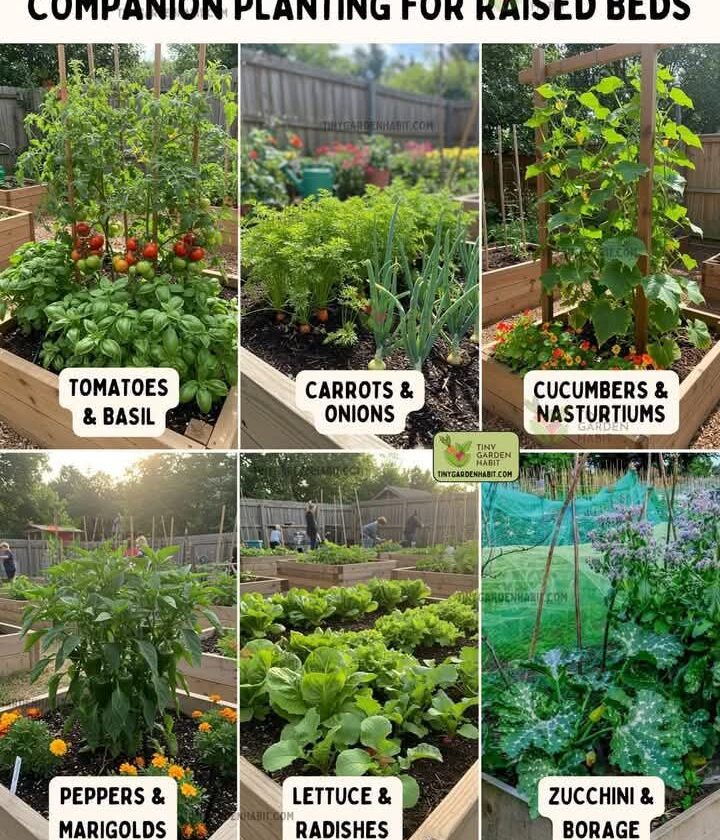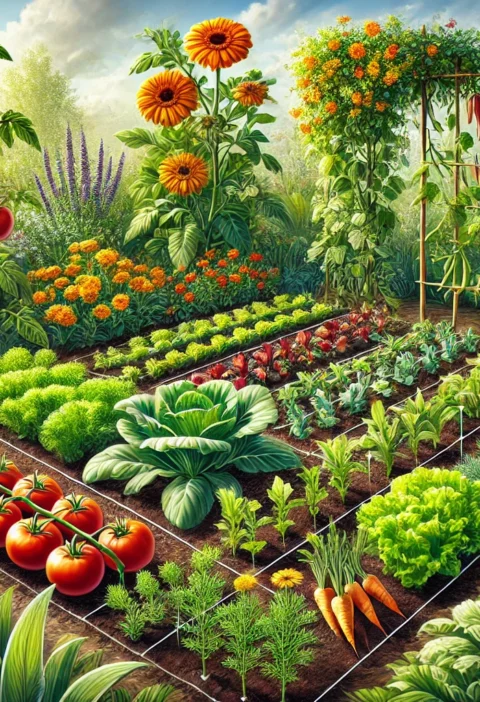The Ultimate Guide to Companion Planting for Raised Beds 🌿🍅
Companion planting is a time-tested gardening technique that helps boost plant health, maximize space, and naturally repel pests—all while enhancing the flavor and yield of your crops. If you’re growing your vegetables in raised beds, companion planting is a game-changer for improving soil health, attracting pollinators, and reducing the need for chemical pesticides.
In this guide, we’ll explore the best companion planting combinations, why they work, and how to create a thriving raised bed garden using this natural gardening strategy.
—
🌱 What is Companion Planting?
Companion planting is the practice of pairing plants that benefit each other when grown together. These benefits include: ✔ Natural pest control – Some plants repel harmful insects that attack their neighbors.
✔ Improved growth & flavor – Certain plant pairings enhance each other’s nutrient uptake and flavor.
✔ Better pollination – Flowers and herbs attract pollinators like bees and butterflies.
✔ Efficient use of space – Tall plants provide shade for delicate crops, and deep-rooted plants loosen the soil for shallow-rooted companions.
—
🌿 Best Companion Planting Pairs for Raised Beds
Here are some powerful plant combinations that will help your raised bed garden flourish:
🍅 Tomatoes & Basil – A Flavorful, Pest-Repelling Duo
✔ Why? Basil repels aphids, mosquitoes, and whiteflies, which commonly attack tomatoes.
✔ Bonus: Basil enhances tomato flavor and attracts pollinators when it flowers.
✔ How to Plant: Space basil plants every 12 inches around your tomatoes.
—
🥕 Carrots & Onions – The Perfect Pest Deterrent
✔ Why? Onions repel carrot flies, while carrots help aerate the soil, making it easier for onions to grow.
✔ Bonus: Onions also deter aphids and caterpillars, reducing damage to carrots.
✔ How to Plant: Alternate rows of carrots and onions for the best effect.
—
🥒 Cucumbers & Nasturtiums – A Pest-Proof Pair
✔ Why? Nasturtiums act as a trap crop, attracting aphids and cucumber beetles away from cucumbers.
✔ Bonus: Nasturtiums add beautiful edible flowers to your garden.
✔ How to Plant: Surround your cucumber plants with nasturtiums or interplant them throughout your bed.
—
🌶️ Peppers & Marigolds – Natural Pest Control Powerhouses
✔ Why? Marigolds repel nematodes, aphids, and beetles that can damage pepper plants.
✔ Bonus: Marigolds attract pollinators and improve soil health.
✔ How to Plant: Plant marigolds around the border of your raised bed or in between pepper plants.
—
🥬 Lettuce & Radishes – A Growth-Boosting Combination
✔ Why? Radishes loosen compacted soil, allowing lettuce roots to grow faster.
✔ Bonus: Radishes deter flea beetles, which attack leafy greens like lettuce.
✔ How to Plant: Scatter radish seeds between lettuce rows for mutual benefit.
—
🥒 Zucchini & Borage – The Ultimate Pollinator Magnet
✔ Why? Borage attracts bees and pollinators, increasing zucchini fruit production.
✔ Bonus: Borage repels squash pests like cucumber beetles.
✔ How to Plant: Grow borage around or next to zucchini plants to maximize benefits.
—
🌻 Additional Companion Planting Combos for a Thriving Garden
🌽 Corn, Beans & Squash – The “Three Sisters” method: Corn provides support for beans, beans fix nitrogen in the soil, and squash shades the ground.
🍆 Eggplant & Thyme – Thyme repels flea beetles that attack eggplants.
🧄 Garlic & Roses – Garlic repels aphids and fungal diseases on rose plants.
🌱 Strawberries & Thyme – Thyme repels worms that damage strawberries.
—
🌍 Why Companion Planting Works
✔ Naturally repels pests – No need for harmful pesticides!
✔ Improves plant growth & flavor – Some plants release compounds that enhance neighboring crops.
✔ Boosts pollination & soil health – Flowers and herbs attract beneficial insects and improve soil conditions.
✔ Saves space in raised beds – Smart pairings maximize space and minimize nutrient competition.
—
💡 Pro Tips for Successful Companion Planting in Raised Beds
✅ Rotate crops each season – Prevents nutrient depletion and reduces pest buildup.
✅ Avoid bad companions – Some plants inhibit each other’s growth (e.g., tomatoes and cabbage).
✅ Group plants by water needs – Place moisture-loving plants together for easier watering.
✅ Use trellises for vining plants – Maximize vertical space for cucumbers, beans, and peas.
—
🌱 Start Your Companion Planting Journey Today!
Companion planting is an eco-friendly way to grow a healthy, productive garden without chemicals. Whether you’re a beginner or an experienced gardener, incorporating these smart plant pairings into your raised beds will lead to stronger plants, fewer pests, and a more abundant harvest.
🌿 What will you plant together this season? Share your favorite companion planting tips in the comments! 🌸💬






